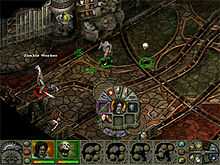Infinity Engine is a game engine which allows the creation of isometric role-playing video games. It was originally developed by BioWare for a prototype RTS game codenamed Battleground Infinity, which was ultimately re-engineered to become the first installment of the Baldur's Gate series. BioWare used it again in the subsequent installments of the series, but also licensed the engine to Interplay's Black Isle Studios.
Infinity Engine features pausable realtime gameplay. The engine uses a three quarters perspective with pre-rendered 2D backgrounds and sprite-based characters. Although graphically 2D for the most part, Baldur's Gate II added the use of OpenGL to accelerate drawing. Designed for six-character party-based adventuring by default, the Infinity Engine was the spiritual successor to the Gold Box Engine,[citation needed] and provided the basis for five Dungeons & Dragons licensed role-playing video games plus additional expansion packs and a number of fanmade total conversion RPGs. It was succeeded by BioWare's Aurora Engine.
A free compatible game engine recreation is in development under the name of GemRB. It runs on multiple platforms, including FreeBSD, Linux, Mac OS X, Windows, Android and AmigaOS 4.[1] Entire suites of reverse-engineered modding tools were written for Windows, Mac OS, and OS X in the engine's heyday.[2]
Games using Infinity Engine
The following games and expansions are powered by the Infinity Engine:
References
External links
|
|---|
|
|
Basics |
|---|
|
General | |
|---|
| Gameplay | |
|---|
| Creators | |
|---|
| Companies | |
|---|
| Licenses | |
|---|
|
| |
| |
|
Player characters |
|---|
|
| |
|---|
| | |
|---|
| Character lists | |
|---|
| Notable characters | |
|---|
|
| |
|
Beasts and other beings |
|---|
|
Creatures and monsters |
|
|---|
| |
Human and Demihuman | |
|---|
| Monster | |
|---|
| Lists by setting | |
|---|
|
|---|
|
| |
|
Publications |
|---|
|
Editions core rulebooks | |
|---|
| Revision rule sets | |
|---|
| Supplements | |
|---|
| Periodicals | |
|---|
| | |
|---|
|
| |
| |
|---|
|
Early games (1975–1983) | |
|---|
| | |
|---|
| | |
|---|
| | |
|---|
| | |
|---|
| | |
|---|
| Other games by
campaign setting |
|
|---|
|
|
|
